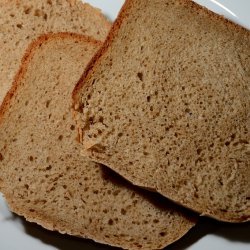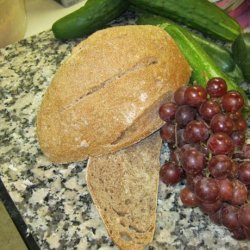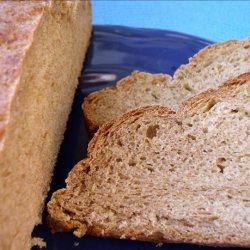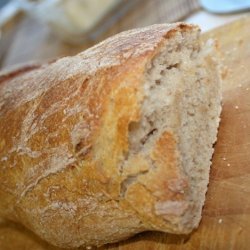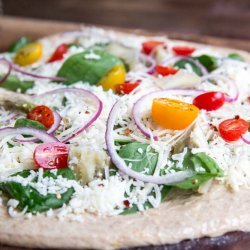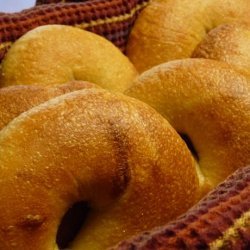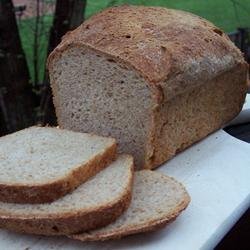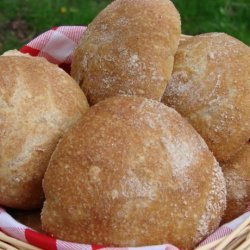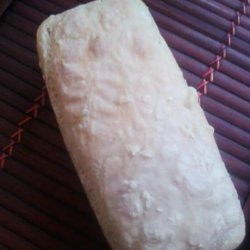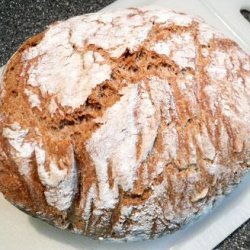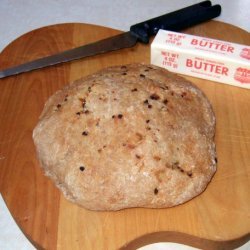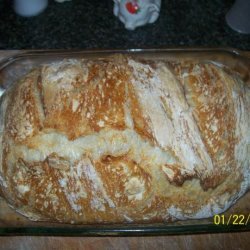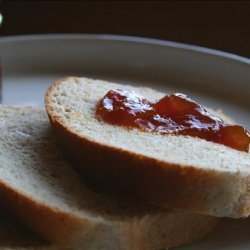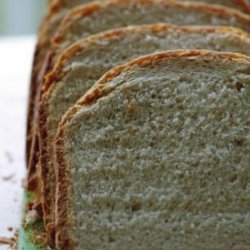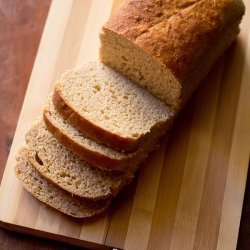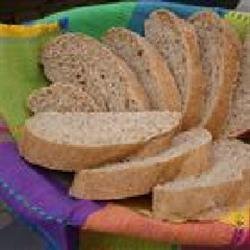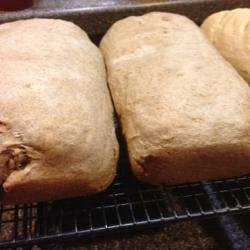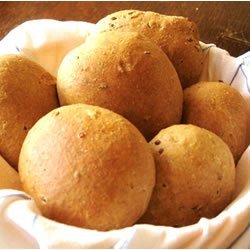Ingredients:
- 4 cups lukewarm water (note -- you can add a tsp of dried herbs to the water for herb-flavored breads.)
Directions:
- 1. Measure the dry ingredients. Use dry-ingredient measuring cups (avoid 2 cup measures, which compress the flour) to gently scoop up flour, then sweep the top level with a knife or spatula. Whisk together the flours, yeast, salt and vital wheat gluten in a 5-quart bowl, or, preferably, in a resealable, lidded (not airtight) plastic food container or food-grade bucket. Lidded (or even vented) plastic buckets designed for dough storage are readily available.
- 2. Mix with water — kneading is unnecessary. Heat the water to slightly warmer than body temperature (about 100 degrees Fahrenheit). Add to the dry ingredients and mix without kneading, using a spoon, food processor (with dough attachment), or heavy-duty stand mixer (with paddle). You may need to get your hands wet to get the flour to incorporate if you’re not using a machine. Don’t knead! It isn’t necessary.
- You’re finished when everything is uniformly moist, without dry patches. This step is done in a matter of minutes, and yields a wet dough that remains loose enough to conform to the shape of its container.
- 3. Allow to rise. Cover with a lid (not airtight) or cover loosely with plastic wrap. Allow the mixture to rise at room temperature until it begins to collapse (or at least flatten on top), which will take about 2 hours. Longer rising times — even overnight — will not change the result. Fully refrigerated wet dough is less sticky and is easier to work with than dough at room temperature. So, the first time you try our method, it’s best to refrigerate the dough overnight (or at least 3 hours) before shaping a loaf.
- After it’s been refrigerated, the dough will seem to have shrunk back upon itself. It will never rise again in the bucket, which is normal for our dough. Whatever you do, do not punch down this dough! With our method, you’re trying to retain as much gas in the dough as possible, and punching it down knocks gas out and will make your loaves denser.
- On Baking Day.
- 4. Quickly shape a loaf. First, prepare a pizza peel by sprinkling it liberally with cornmeal (or lining it with parchment paper or a silicone mat) to prevent your loaf from sticking to it when you slide it into the oven. Dust the surface of your refrigerated dough with flour. Pull up and cut off a 1-pound (grapefruit-size) piece of dough, using a serrated knife or kitchen shears. Hold the mass of dough in your hands and add a little more flour as needed so it won’t stick to your hands. Gently stretch the surface of the dough around to the bottom on all four sides, rotating a quarter-turn as you go to form a ball. Most of the dusting flour will fall off; it’s not intended to be incorporated into the dough. The bottom of the ball may appear to be a collection of bunched ends, but it will flatten out during resting and baking. The correctly shaped final product will be smooth and cohesive.
- 5. Form a narrow, oval-shaped loaf and let it rest. Stretch the ball gently to elongate it, and taper the ends by rolling them between your palms and pinching them.
- 6. Allow the loaf to rest — covered loosely with plastic wrap — on the pizza peel for 90 minutes (40 minutes if you’re using fresh, unrefrigerated dough).
- Alternatively, you can allow the loaf to rest on a silicone mat or greased cookie sheet. Depending on the age of the dough, you may not see much rise during this period. More rising will occur during baking.
- 7. Thirty minutes before baking, preheat the oven to 450 degrees, with a baking stone placed on the middle rack. Place an empty broiler tray for holding water on any other rack that won’t interfere with the rising bread.
- 8. Paint and slash. Just before baking, use a pastry brush to paint the top of the loaf with a little water. Sprinkle with the seed and nut mixture. Slash the loaf with quarter-inch-deep parallel cuts across the top, using a serrated bread knife.
- 9. Baking with steam. After a 30-minute preheat, you’re ready to bake. With a quick forward jerking motion of the wrist, slide the loaf off the pizza peel and onto the preheated baking stone. If you used parchment paper instead of cornmeal, it will slide onto the stone with the loaf. If you used a silicone mat or cookie sheet, just place it on the stone. Quickly but carefully pour about a cup of hot water into the broiler tray and close the door to trap the steam. Bake for about 30 minutes, or until the crust is richly browned and firm to the touch (smaller or larger loaves will require adjustments in resting and baking time).
- If you used parchment paper, a silicone mat, or a cookie sheet under the loaf, carefully remove it and bake the loaf directly on the stone or an oven rack when the loaf is about two-thirds of the way through baking.
- When you remove the loaf from the oven, it may audibly crackle, or “sing,” when initially exposed to room-temperature air. Allow the bread to cool completely, preferably on a wire cooling rack. The perfect crust may initially soften, but will firm up again when cooled.
- 10. Store the remaining dough in your container in the refrigerator and use it over the next couple of weeks. You’ll find that even one day’s storage im¬proves the flavor and texture of your bread. The dough ferments and takes on sourdough characteristics. When your bucket is empty, don’t wash it! Mix another batch in the same container. The aged dough stuck to the sides will give you a head start on sourdough flavor. To take it even further, incorporate up to 2 cups of your old dough.
Nutrition Facts
| Amount Per 1 Serving | |||
| Calories | 653.86 Kcal (2738 kJ) | ||
| Calories from fat | 17.37 Kcal | ||
| % Daily Value* | |||
| Total Fat | 1.93g | 3% | |
|---|---|---|---|
| Sodium | 449.22mg | 19% | |
| Potassium | 312.39mg | 7% | |
| Total Carbs | 132.2g | 44% | |
| Sugars | 0.12g | 0% | |
| Dietary Fiber | 4.28g | 17% | |
| Protein | 23.05g | 46% | |
| Iron | 11.6mg | 64% | |
| Calcium | 41.9mg | 4% | |
| Amount Per 100 g | |||
| Calories | 355.89 Kcal (1490 kJ) | ||
| Calories from fat | 9.45 Kcal | ||
| % Daily Value* | |||
| Total Fat | 1.05g | 3% | |
|---|---|---|---|
| Sodium | 244.5mg | 19% | |
| Potassium | 170.03mg | 7% | |
| Total Carbs | 71.96g | 44% | |
| Sugars | 0.07g | 0% | |
| Dietary Fiber | 2.33g | 17% | |
| Protein | 12.54g | 46% | |
| Iron | 6.3mg | 64% | |
| Calcium | 22.8mg | 4% | |
* Percent Daily Values are based on a 2000 calorie diet. Your daily values may be higher or lower depending on your calorie needs.
Find out how many calories should you eat.
Get Your Recipe of Health!
Follow RecipeOfHealth on Facebook!


